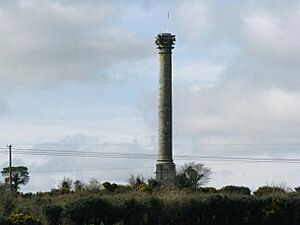Browne-Clayton Monument facts for kids
The Browne-Clayton Monument is a huge stone column in Leinster, Ireland. It stands about 28.75 meters (94 feet) tall. This special monument was built in the 1800s. It looks like an ancient Greek or Roman column, with fancy carvings at the top. You can find it on Carrigadaggan Hill, near Carrigbyrne in County Wexford. It's close to the N25 road, between the towns of Wexford and New Ross. The monument was designed to look like an old Roman column called Pompey's Pillar in Alexandria, Egypt. That pillar was built to honor a Roman emperor named Diocletian.
Contents
History of the Browne-Clayton Monument
The Browne-Clayton Monument is very special because it's the only column of its kind that you can go inside. It has a staircase that goes all the way to the top! From there, you can see amazing views of the countryside. Workers started building it in 1839 and finished in 1841. It was made from strong Mount Leinster granite.
The famous English architect, Thomas Cobden, designed this monument. He also designed the beautiful Cathedral of the Assumption in Carlow Town.
General Robert Browne-Clayton of Carrigbyrne built the monument. He wanted to honor his commanding officer, Sir Ralph Abercromby. They fought together and won battles against Napoleon in Egypt in 1801. Sadly, Abercromby was badly hurt during the Battle of Alexandria and later died.
Locally, some people call the monument "Browne's Nonsense." A story says that General Browne-Clayton built it for his son, who he thought had died in battle. But soon after the column was finished, his son showed up alive and well! These events make the column important to history around the world.
Lightning Strikes the Monument
On December 29, 1994, lightning hit the Browne-Clayton Monument. This caused a lot of damage to the top part of the column. A big hole appeared, and rocks fell inside, blocking the stairs.
To help fix the monument, a group called Wexford Monument Trust Ltd. was started in 2001. This group included people from the Wexford County Council, the World Monuments Fund from Britain, and An Taisce. Their goal was to get, fix, and protect the monument.
Restoring the Monument
The work to restore the monument began in July 2002. Experts first wrote a report on how to repair it. They suggested doing the repairs in two main steps.
The first step, an emergency repair, finished in November 2002. This involved making a temporary path to the column. Workers also put up scaffolding to support the column. They carefully removed the damaged top section.
The second step, to complete the restoration, started in July 2003. This involved replacing or fixing the damaged stone parts. The workers then put the top section back together. The whole restoration was finished in November 2003.
Support for the Restoration
The monument's restoration was a big success. It happened thanks to generous money from many groups. These included Wexford County Council, the World Monuments Fund in Britain, and the Department of the Environment. The Heritage Council and An Taisce also helped, along with many private people who donated money.
As part of the restoration, a special path was made from the main road to the monument. The land where the monument stands is now owned by the Trust. This means people can easily visit and enjoy this historic site.
Interesting Facts About the Monument
- Total number of sections: 78
- Number of sections in the top part: 9
- Weight of the repaired top part: 32 tonnes
- Weight of each main column section: 3.5 tonnes


